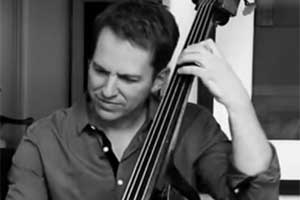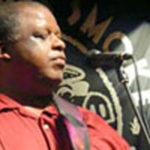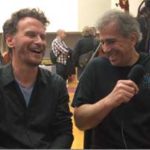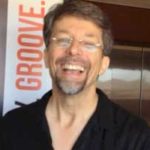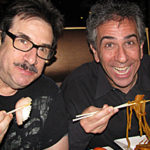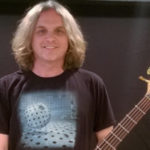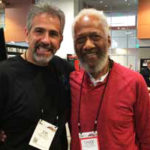From Ella Fitzgerald and Mel Tormé to Gladys Knight and Stevie Wonder, Larry Steen has done it all! Here’s our conversation with this master doubler!
Exclusive interview with FBPO’s Jon Liebman
July 23, 2012
Bassist/composer/producer Larry Steen has been declared “A giant of the not too distant future” by the Los Angeles Times. Equally proficient on both fretted and fretless electric bass, as well as classical and jazz upright bass, Larry’s accomplishments are nothing short of remarkable.
Steen has performed and/or recorded with a wide array of top-name performers, cutting across all genres. The list includes everyone from Ella Fitzgerald, Rosemary Clooney, Billy Eckstine and Mel Tormé to Bennie Maupin, Louis Bellson, Bob Sheppard, Airto Moreira and Flora Purim. He has also performed with Barry Manilow, Engelbert Humperdinck, Melissa Manchester and Jimmy Buffett, as well as Gladys Knight, Stevie Wonder, Dave Koz and Steve Vai.
Larry has played bass on numerous TV and radio recordings, including Roswell, Providence, Felicity, Once and Again, Beverly Hills 90210, Power Rangers, General Hospital, Entertainment Tonight and many others. His debut CD, First Move, features jazz luminaries Ernie Watts, Dave Weckl, Otmaro Ruíz and others, including Yellowjackets bassist Jimmy Haslip, who served as executive producer. His latest release, View from Afar, recorded by the Larry Steen World Jazz Ensemble, features Robben Ford, Ernie Watts, Russell Ferrante, Doug Webb and other notable musicians.
Steen graduated Magna Cum Laude from the University of Miami with a degree in Studio Music & Jazz. He also received a Master of Fine Arts degree in Jazz and African American Music Performance from California Institute of the Arts (CALARTS), where he studied with bassists Gary Willis and Jeff Berlin.
FBPO: How would you describe your musical upbringing?
LS: I come from a music and arts-oriented family. My father worked his way through high school, college and medical school playing piano on “society swing” gigs. My mother plays the cello and several other instruments. We always went to see symphonic, ballet and jazz concerts ever since I can remember. With the urging of my music-loving, violinist grandmother, I started violin lessons using the Suzuki Method, an approach which emphasizes learning by ear, at the age of 4 and-a-half on a quarter-size violin! It only lasted a couple of months. I wasn’t ready yet and, fortunately, my mother didn’t make me stick with it. That turned out to be a smart move on her part because it allowed music at the earliest age to be an enjoyable activity, not something I had to do.
At 8, I started piano lessons with Emel Gokcen, who was my teacher for about five years. She was one of my first musical mentors and like a godmother to me, so inspiring and loving. She’d play a piece that I was starting to learn and I can remember my goose bumps. At 9, I started back up with the violin.
FBPO: How did you end up a bass player?
LS: Like most teenage kids, I wanted to be cool and play in a rock band and, like many, the decision to play bass was initially more out of practicality than some mysterious magic about the instrument. After all, there were enough guitar players! The bass had four strings, like the violin. I mean, how different could it be?
It wasn’t until I obtained my first instrument, a short-scale Fender Musicmaster, that I realized the tuning was in ascending fourths, not fifths. Fortunately, my concerns quickly melted away when I started copping bass lines off all my favorite records and jamming with friends.
 FBPO: So you played electric before you learned the upright?
FBPO: So you played electric before you learned the upright?
LS: Yes. While I fooled around with the upright during my senior year of high school, I didn’t get serious about it until college. After taking my first upright lesson, the teacher told me that I wasn’t yet ready for Berklee and warned that I’d be too intimidated by the more skilled students. I ignored his advice and started fall semester there following high school graduation. Of course, I was intimidated but needed to be kicked in the ass! I diligently practiced and studied, as well as jammed, catching up quickly. Aside from not knowing the upright, I really knew very little about jazz before starting there.
FBPO: Did you go through the traditional learning process on the upright, with the bow, Simandl, etc?
LS: At Berklee, I had a no-nonsense, nuts-and-bolts teacher named John Repucci, who had me working through the Nanny books, kind of like the French version of the Simandl books. He also had me transcribing jazz bass solos every week, crucial for developing my jazz melodic vocabulary, which went hand-in-hand with my ever-increasing jazz theory and harmony knowledge.
FBPO: Who were your influences as a young, up-and-coming student of bass?
LS: As a teenager playing in a few garage cover bands, I was into all the classic rock stuff. John Paul Jones of Led Zeppelin was one of my faves. His playing on “The Lemon Song” from the Led Zeppelin II album was my gateway to the funkier side of the bass, which opened me up to P-Funk, the Ohio Players, James Brown, etc.
Later in high school, I got into fusion, especially Return to Forever, Weather Report and Jeff Beck. By senior year, I was in a New Wave band and into mod and ’80s ska. Even then, my tastes were quite eclectic. It wasn’t until college that I dove into bop and modern, modal jazz styles, followed later by Latin, Brazilian and various world styles.
FBPO: Tell me a little more about your experience at Berklee.
LS: Berklee was – and, I’m sure, still is – a great environment to get a lot of shit together. Unlike the more experienced students, I didn’t intend for it to be a temporary networking stop-off for tours and gigs. However, after my thin California blood could only take two years of those brutal winters, I was referred by a Berklee alumni friend for a cruise ship gig out of Miami and happily obliged.
FBPO: How about the University of Miami? What were you looking for when you enrolled?
LS: After working on the cruise ships out of Miami for a semester, I knew I wanted to go back to school to finish my bachelor’s degree. In those days, Miami, along with Berklee and North Texas State, was one of the best jazz/studio music schools in the country. Like Berklee, it was a great disciplined environment, with great teachers and great players. While it didn’t have as many facilities as Berklee at that time, it did have the advantage of more personal attention from the faculty and a more communal vibe because of its limited enrollment numbers. The music school was a small subsection of the university.
FBPO: You studied with Jeff Berlin at CALARTS. While I consider Jeff a good friend, he and I have gotten into some pretty “spirited” discussions about music education, about which he is very passionate. Tell me about your experience with him.
LS: I’m sorry to say that I only had a limited number of lessons with Jeff because, by the time I was doing my master’s at CALARTS, I was entrenched as a gigging musician in LA and didn’t have an easy time coordinating lesson times with him. That said, I mostly agree with his values regarding teaching and learning. Most importantly, I appreciate his emphasis on the importance of reading music, especially reading well, the multitude of reasons I won’t go into now. He is a virtuoso on the instrument and has a systematic approach to teaching that is invaluable.
FBPO: How did you manage to break in to the LA music scene? That’s no small feat!
LS: After I told one of my bass teachers at Miami – jazz bass chair, Don Coffman – of my intentions to move to LA, he encouraged me to audition for the International Society of Bassists’ Jazz Competition that was to be held there later that year. Because of the subjective nature of music, I always thought competitions were silly, but realized the networking potential of participating. So I auditioned, made the semi-finals, finals and ended up winning. I immediately hung out at clubs several nights a week, sitting in when appropriate, going to jam sessions and union rehearsals, the usual way musicians would meet each other before these days of online and social networking. One thing just led to another.
FBPO: I’m very intrigued by the way your music incorporates elements from many different cultures. Tell me about that.
LS: In addition to music and the arts, my family values the experience of international travel and the diversity of cultures that are, unfortunately, diminishing in this Age of Information and globalization. This appreciation includes music which I’ve experienced via my world travels, the Cuban/Colombian culture in Miami, various world music classes at CALARTS, as well as the multiculturalism of LA. It seems natural for me to meld my eclectic background into my world jazz, which fuses authentic global rhythms and textures with the complex harmony of jazz and classical music.
FBPO: What’s keeping you busy these days?
LS: Freelancing in a variety of situations, live and in the studio; teaching lessons at El Camino College, as well as privately; working on a soul/R&B project with my vocalist-wife Nikki; doing professional fine art and commercial photography; regular exercise; enjoying the summer boogie boarding season, nature, our dog, the hang with friends for a nice meal with good wine and planning the next big trip!
FBPO: How about the future? What else would you like to do that you haven’t already accomplished?
LS: More performances around the world of grooving and creative music with great musicians for appreciative audiences. Keeping the “spark” alive is key, while not letting the business drag me down. More international travels and “experiences of a lifetime” are part of the picture as well.
FBPO: What would you be if you weren’t a bass player?
LS: Well, I already am taking photography on as a second career. I’ve done several shows of my fine art travel photography and am planning on continuing in that direction. It’s great having an alternate, creative outlet outside of music.
Larry Steen: In-studio upright solo
Larry Steen: Live solo on electric
